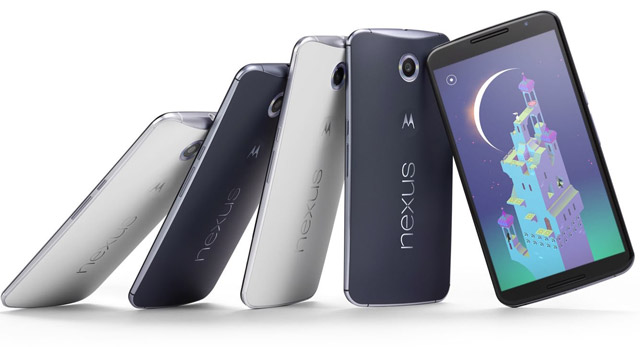
Previously launched Nexus smartphones, like the Nexus 5, were accompanied by two characteristic features that made them very popular. They were always preinstalled with a stock version of the Android operating system and they offered high-end specifications at low-end prices.
The new Nexus 6, however, is by far the most expensive version to date and also happens to be the biggest one yet. It comes preinstalled with Android 5 (Lollipop) bringing a lot of new options and features.
To find out how the new Nexus 6 performs and handles in practice, I ditched my iPhone and promoted the Nexus to the rank of primary device for a full week. (Although the Nexus 6 is available in 32GB and 64GB storage capacity versions, I used the 32GB model for this review.)
During that week I used the Nexus 6 for typical home and office activities like e-mail, Skype, browsing, watching YouTube in high definition, playing modern 3D games and working with all sorts of office-related documents. To give me some valuable insight into the actual performance of the internal hardware of the Nexus 6, like the CPU and the battery, I used a set of specialised benchmark tools.
I measured the quality of the screen by using dedicated hardware. The cameras were tested by simply shooting various pictures and videos in different scenarios and situations.
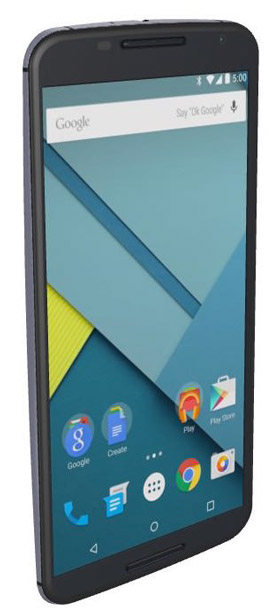 Look and feel: curved giant
Look and feel: curved giant
Let’s get straight to the point: the 5,96-inch Google Nexus 6 is a huge smartphone. It measures almost 16cm in length and 8,3cm in width, making it even bigger than the already oversized Samsung Galaxy Note 4, Apple iPhone 6 Plus and the new Huawei Ascend Mate 7. Sure, there are even bigger phones available, like the Nokia Lumia 1520 and the Sony Xperia Z Ultra, but there’s no denying the fact that the Nexus 6 is a giant.
Designwise, the Nexus 6 clearly breaks tradition with earlier Nexus devices. Its edges are visibly sharper than those of the Nexus 5 and the plastic back of the new phone is slightly curved, a characteristic of recent Motorola phones. The curved back may sound like just a small detail but it isn’t. It helps to get a solid grip on the Nexus 6, which is important given its size. In fact, the curved back feels so right and intuitive that I wouldn’t mind seeing it on more future phones from other manufacturers.
Just like the latest Motorola smartphones, the Nexus 6 has been fitted with front-facing speakers. There’s one above the screen and one below it. The sound they produce is excellent, but falls short in the low-frequency range. Although the sound quality can’t compete with that of high-end HTC smartphones like the One M8, it comes pretty close.
While the curved back is made of rather cheap looking plastic — which tends to emphasise greasy finger smudges — the sides are made from metal, helping give the Nexus 6 a somewhat premium look and feel. Compared to the materials that Motorola normally uses in its phones — like bamboo, leather and even Kevlar — the plastic/metal combination on the Nexus 6 is disappointingly ordinary. Despite the primarily plastic exterior, the Google Nexus 6 still feels very durable and solid.
Hardware: quad-core and 4G+
Like all previous Nexus devices that were equipped with Qualcomm’s newest generation of Snapdragon processors (at the time of release), so is the Nexus 6. It houses the latest and greatest quad-core Snapdragon 805 system-on-a-chip that is specifically designed for high-end smartphones and has each core running at a maximum of 2,7GHz. The raw processing power of the Nexus 6 should, at least in theory, be similar to that of the Samsung Note 4 because they make use of the same processor.
The Snapdragon 805 will be Qualcomm’s final chip to utilise the 32-bit Krait-core technology introduced in 2012. Newer generations of Snapdragon chips, like the 808 and 810, will depend on ARM’s Cortex A57 and A53 cores, also known as the big.LITTLE technology. Smartphones using the new 808 and 810 chips are expected to reach the South African market later this year.
To handle complex 3D graphics, the Nexus 6 houses an Adreno 420 graphics processing unit (GPU), also from Qualcomm. Compared to the Adreno 330 GPU that the Nexus 5 is fitted with, this new GPU should deliver performance improvements of up to 40%. The Nexus 6, however, has more pixels to manage, which mostly neutralises the extra processing power of the GPU, resulting in almost identical benchmark scores.
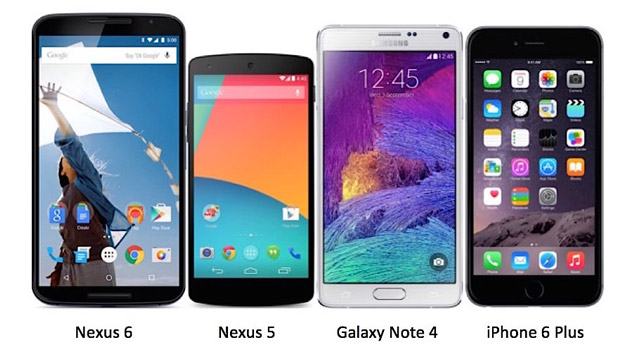
The Google Nexus 6 is one of the few smartphones currently available that supports 4G+/LTE Cat6 mobile networks. This new, faster version of 4G, which is currently being rolled out in parts of Europe and the US, isn’t yet available in South Africa. However, it’s only a matter of time before it will also reach these shores. Early support for these new and faster networks makes the Nexus 6 future proof and a pretty sure bet if you want to be online at the highest possible speed wherever you are, now or in the near future. Other high-end smartphones that can handle 4G+/LTE Cat6 include the Samsung Galaxy Note 4 and the Huawei Ascend Mate 7.
The Nexus 6 also supports the latest 802.11ac Wi-Fi standard as well as Bluetooth 4.1 for short-range wireless communication.
Although the Google Nexus 6 is also available with 64GB of storage capacity, of which 55GB is actually available for user content, it’s a shame there’s no way to add more storage capacity via SD cards. There are loads of low-end smartphones that do allow easy expansion, making them more future-proof and suitable for use with big files than this high-end, high-priced Nexus 6.
Benchmarks: best for gaming
To find out how the Snapdragon 805 and Adreno 420 GPU perform, I used a set of benchmark tools. I compared the Nexus 6 with the 6-inch Huawei Ascend Mate 7, the 5,7-inch Samsung Galaxy Note 4 and the 5,5-inch Apple iPhone 6 Plus.
The first benchmark, Geekbench, simulates real-world consumer and business scenarios to determine the maximum performance of the CPU, GPU and RAM. It made it clear that the Nexus 6 isn’t the fastest horse on the track, but easily outperforms the Apple iPhone 6 Plus.
I then ran a second benchmark tool called Peacekeeper. This one also takes the operating system and browser into account, as well as the internal hardware. Peacekeeper mostly confirmed what Geekbench had presented earlier: the Nexus 6 has trouble keeping up with the three other smartphones used in this test. Surprisingly, the iPhone 6 Plus does exceptionally well during this specific test run.
The third benchmark tool is named Kraken and also factors in the operating system, browser and internal hardware. Again, this test confirmed that the Nexus is no top scorer, but this time the differences with the other three phones aren’t that big.
Finally, I specifically decided to benchmark the graphics performance of the Nexus 6, essentially testing the performance of its GPU. For that, I made use of a program called 3DMark. The GPU is clearly able to deliver considerably better performance than the other three smartphones, making the Nexus 6 a smart choice if you plan to do a lot of mobile gaming.
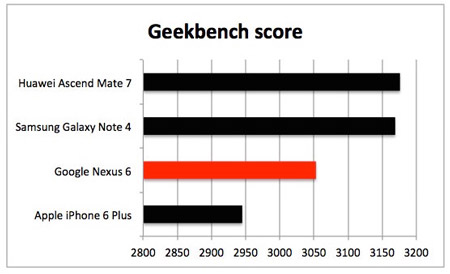
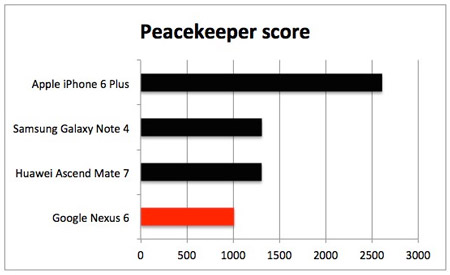
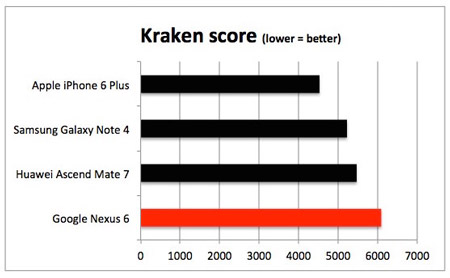
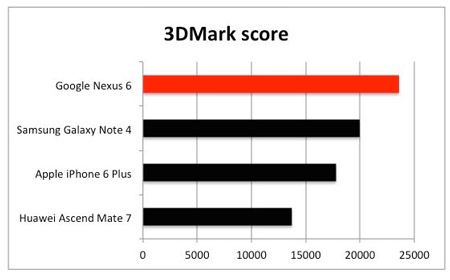
Screen: high contrast, low brightness
Both the Nexus S (2010) and Galaxy Nexus (2011) were fitted with Amoled screen technology, while the Nexus 4 and 5 (both manufactured by LG) featured LCD displays. Now, with the Nexus 6, Google and Motorola decided to return to Amoled and to fit it with a 5,96-inch screen delivering a resolution of 2 560 x 1 400 pixels (QHD) for a pixel density of 493ppi.
In practice, the screen of the Nexus 6 is able to display razor-sharp images and text. To measure the brightness, contrast and colour reproduction of the Google Nexus 6, I used the SpectraCal C6 Colorimeter. With a relatively low brightness value of just 355 candela per square meter, it pales compared to the brightness levels of competitive smartphones. To put things into perspective; the Samsung Galaxy Note is able to display 610cd/m2, the Apple iPhone 6 Plus 510cd/m2 and the Huawei Ascend Mate 7 440cd/m2. The low brightness will not pose a problem when using the Nexus 6 indoors. However, in a sunny environment, the screen will be difficult to read comfortably.
A screen’s contrast is determined by the ratio of the luminance of the brightest colour (white) to that of the darkest colour (black). Because the Nexus 6 uses Amoled technology that doesn’t make use of backlighting, like LCD does, it can achieve a contrast ratio of 10 000:1. Popular smartphones with LCD screens have contrast ratios of 1 620:1 (HTC One M8), 1 340:1 (Apple iPhone 6 Plus) and 1 290:1 (Huawei Ascend Mate 7). Bottom line: the Nexus 6 delivers excellent contrast compared to competitive devices because of the use of Amoled instead of LCD.
The reproduction of realistic colours by the Nexus 6 is also excellent, according to the specialised hardware I used. Some colours are just a bit oversaturated, but not to the degree that it becomes irritating. When holding the Nexus 6 at a certain viewing angle, white parts of the screen show a slight green/pink glow, but again this is not irritating and probably won’t even be noticed by most people.
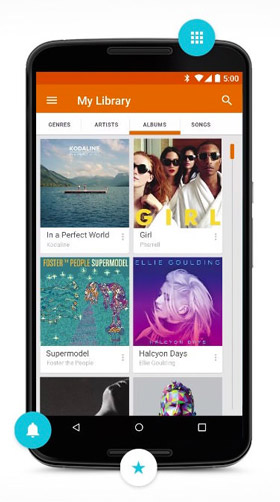 Battery life: room for improvement
Battery life: room for improvement
The non-removable battery inside the Nexus 6 holds a relatively high capacity of 3 220mAh. It’s not the highest I’ve come across, however — that honour belongs to the Huawei Ascend Mate 7, which houses an incredible 4 100mAh unit. To put this into perspective, the Samsung Galaxy Note 4 uses a 3 220mAh battery, the Sony Xperia Z3 Compact depends on a 3 100mAh version, the Apple iPhone 6 Plus works on a 2 900mAh model and the HTC One (M8) houses a “mere” 2 600mAh unit.
Let’s face it, a smartphone simply can’t have too much battery capacity. Most people have grown accustomed to the fact that their smartphone needs to be connected to a charger at the end of a day. For some smartphones, like the new Samsung Galaxy Alpha, simply reaching the end of the day is a small miracle in itself. Other smartphones, like the Ascend Mate 7, can survive for two days without have to be refuelled. The previous Nexus 5 smartphone is a good example of what we don’t need to see anymore. It combined a full-HD screen with a tiny, 2 300mAh battery, leading to disappointed buyers.
To find out how the battery of the Nexus 6 performs in real-life, I used two separate tests to get an accurate indication. Both tests try to drain the battery as fast as possible, effectively creating a worst-case scenario. The first test continuously plays a full-HD movie until there is no more energy left. The second test simulates typical home and office activities such as communicating, browsing and editing documents.
With the video test, the Nexus 6 has the distinct advantage of Amoled, which is a lot more energy efficient than LCD at displaying the colour black. As a result, the Nexus 6 holds out almost 10 hours straight on a fully charged battery. That’s not as good as the Samsung Galaxy Note 4 and the Huawei Ascend Mate 7, but slightly better than the iPhone 6 Plus.
The second part of the battery test stresses the battery a lot more since it requires continuous rendering of websites, text and images and also involves a lot of scrolling. As a result, the Nexus 6 bails after only five hours and 45 minutes, which is about 30 minutes longer than the Nexus 5, but still a few hours less than competing devices.
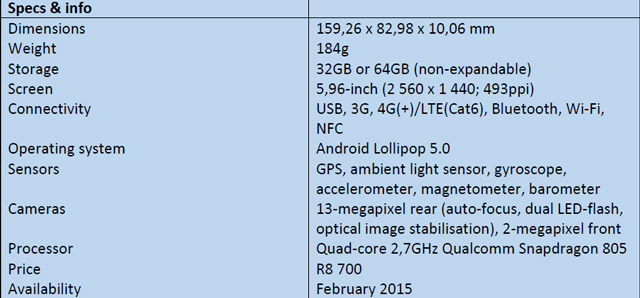
Since with typical smartphone use the screen isn’t switched on all the time and the phone itself also goes into idle mode quite frequently, the Nexus 6 will most likely make it to the end of ordinary day at the office. Don’t expect it to have much energy left when heading for bed though.
Included with the Nexus 6 is a “Turbo Charger” based on Qualcomm’s Quick Charge 2.0 technology. It features three output modes: normal (5V; 1,6A), turbo mode 1 (9V; 1,6A) and turbo mode 2 (12V; 1,2A). Depending on the specific properties and quality of the electrical network, it chooses an optimal mode. In my case, the charger automatically selected turbo mode 1, resulting in 14,4W flowing into the Nexus 6 at one point. At that charge rate, the battery went from completely empty to 25% capacity in just 17 minutes. Ultimately, it took just over two hours to charge fully, which is quite impressive.
I also used a standard charger to see how long that would take to charge the Nexus 6 fully. After three-and-a-half hours, the battery was completely filled up, considerably longer than it took for the Quick Charge 2.0 charger.
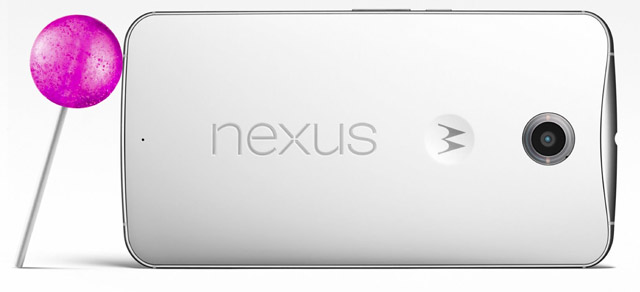
Cameras: good, but not exceptional
The Nexus 6 features two cameras. The rear one can shoot high-dynamic range pictures at a resolution of 13 megapixels and videos in 4K and 1080p resolution at 30fps. For some reason, sound accompanying the recorded video is only in mono. The on-board sensor houses 1,12µm size pixels, smaller than those on the iPhone 6 (1,4µm). The rear camera is fitted with optical image stabilisation (OIS) to reduce the effects of shaky hands. Compared to the much cheaper digital image stabilisation (DIS), OIS uses actual moving mechanics inside the camera to intercept and neutralise tiny vibrations. DIS delegates that task to software algorithms and generally leads to inferior image and video quality.
The rear camera on the Nexus 6 is also equipped with a dual LED-flash that disperses generated light via a ring surround the lens. There is no apparent advantage to the ring but it is an elegant way to hide two LED lights in the design. It’s a good thing that Google and Motorola chose to supply the Nexus 6 with two LED flashes since the sensor can’t handle low-light situations well, as I found out after a light-deprived test run. Again, it’s an elegant way to compensate for the cheaper sensor with smaller pixels.
Another test that I conducted with simulated shaky hands showed that the optical image stabilisation works quite well but can’t match the excellent stabilisation on Sony’s Xperia Z3 smartphone. Also, it seems to have difficulty with auto-focus in some scenarios.
The front camera on the Nexus 6 can be used to take pictures at a 2-megapixel (1 920×1 080) resolution, or to do some decent video conferencing in full-HD quality. Compared to the rear camera, auto-focus is fast and accurate and the automatic settings prove sufficient. The overall quality of the front camera is good enough, but only when ample light is available. I have seen better ones though, like on the Samsung Galaxy Note 4.
Conclusion
With the Nexus 6, Google and Motorola have failed to deliver a smartphone whose predecessors have offered high-end specifications at a lower-end price. Instead, they’ve managed to create a device that’s too big for most pockets and can’t impress with powerful performance or breakthrough battery life.

It’s not all bad, though. Because the Nexus 6 is fast with complex 3D graphics and can display HD movies for 10 hours straight, it’s a great device for game and movie fanatics. The big screen with great contrast and colour reproduction, as well as the good sound quality, ultimately accentuate what the Nexus 6 should be used and bought for: entertainment.
Our overall rating? Six of out 10. — (c) 2015 NewsCentral Media




